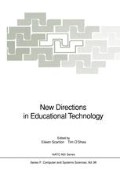Abstract
A drift towards increased content expressed in texts and tests, driven by the growth of science and a demand for results and measurable progress, has trivialized science education. Three technologies are suggested to address this problem.
This work was supported in part by grants from the National Science Foundation grants DPE-8317155, MDR-8550373, and MDR-8652120 to TERC, the Fund for the Improvement of Post-Secondary Education(FIPSE) through the Tools for Scientific Thinking Project at Tufts University, the Board of Regents of Massachusetts, and donations from Apple Computer, Inc. The findings and opinions reported here are those of the authors and do not necessarily reflect the views the funding agencies.
Access this chapter
Tax calculation will be finalised at checkout
Purchases are for personal use only
Preview
Unable to display preview. Download preview PDF.
References
Boxer [a programming language]. See Plager, D. and diSessa, A., Boxer research: An annotated bibliography, The Boxer Group, Graduate School of Education, University of California at Berkeley, 1987.
Brasell, H.M., Effectiveness of the microcomputer-based laboratory in learning distance and velocity graphs, doctoral dissertation, University of Florida, 1986.
Bringuier, J. C., Conversations with Piaget, University of Chicago Press, Chicago, 1980.
Clement, J. & Lochhead, J., On hobgoblins and physics, University of Massachusetts, Amherst, 1979.
Excel [a graphing spreadsheet program], Microsoft.
Grant Foundation., The forgotten half: non-college youth in America, Washington D.C. 1988.
Greenfield, L.B., Engineering student problem solving. In J. Lochhead and J. Clement, Eds., Cognitive Process Instruction, The Franklin Institute, Philadelphia, p. 229–238, 1979.
Halloun, I. A. Hestenes, D., Common sense of college physics students. American Journal of Physics, 53 (11), 1043–1055, 1985.
Hurd, P.D., State of pre-college education in mathematics and science. Science Education, 67 (1), 57–67, 1983.
Laws, P., Workshop physics: replacing lectures with real experience. Proceedings of the Conference on Computers in Physics Instruction, North Carolina State University, 1988.
Lochhead, J., The heuristics laboratory dialogue groups, University of Massachusetts, Amherst, 1976.
McCloskey, M., Caramazza, A.,Green, B., Curvilinear motion in the absence of external forces: Naive beliefs about the motion of objects Science, 210, (December 5), 1139–1141, 1980.
Motion Unit [software hardware], Queue, 562 Boston Ave., Bridgeport, CT 06610.
National Commission on Excellence in Education, A nation at risk, 1983.
Northwest Regional Educational Laboratory, Computer lab tools for science. Portland, OR.
Papert, S. 0026 Tinker, R., The MIT Educational Technology Center. Proposal, MIT, June., 1988.
Papert, S., A critique of technocentrism in thinking about the school of the future. MIT, 1987.
Second International Mathematics Study, The underachieving curriculum, Champaign, IL: Stipes Publishing Company, 1987.
Second International Science Study, Science achievement in seventeen countries, New York: Pergamon Press, 1988.
Stella [modelling software], Lyme, NH: High Performance Systems.
Thornton, R. K., Tools for scientific thinking, Proposal to FIPSE, U.S. Department of Education, 1985.
Thornton, R. K., Access to college science: microcomputer-based laboratories for the naive science learner. Collegiate Microcomputer, V (1), 1987a.
Thornton, R. K., Tools for scientific thinking: microcomputer-based laboratories for physics teaching. Physics Education, 22, p. 230, 1987b.
Thornton, R. K., Tools for scientific thinking: learning physical concepts with real-time laboratory measurement tools. Proceedings of the Conference on Computers in Physics Instruction, North Carolina State University, 1988.
Tinker R. and Barclay W., Development of microcomputer-based laboratory instructional materials. Cambridge: Technical Education Research Centers, 1983.
Trowbridge, D.E. and McDermott, L.C., Investigation of student understanding of the concept of velocity in one dimension American Journal of Physics, 48, (12), 1020–1030, 1980
Zuman, J. with Kim, H., The successful use of MBL in large urban classrooms, (in press).
Zuman, J. with Weaver S., Tools for teaching problem solving: an evaluation of a modelling and systems thinking approach Presented at NARST in April, 1988.
Author information
Authors and Affiliations
Editor information
Editors and Affiliations
Rights and permissions
Copyright information
© 1992 Springer-Verlag Berlin Heidelberg
About this paper
Cite this paper
Tinker, R.F., Thornton, R.K. (1992). Constructing Student Knowledge in Science. In: Scanlon, E., O’Shea, T. (eds) New Directions in Educational Technology. NATO ASI Series, vol 96. Springer, Berlin, Heidelberg. https://doi.org/10.1007/978-3-642-77750-9_13
Download citation
DOI: https://doi.org/10.1007/978-3-642-77750-9_13
Publisher Name: Springer, Berlin, Heidelberg
Print ISBN: 978-3-642-77752-3
Online ISBN: 978-3-642-77750-9
eBook Packages: Springer Book Archive

